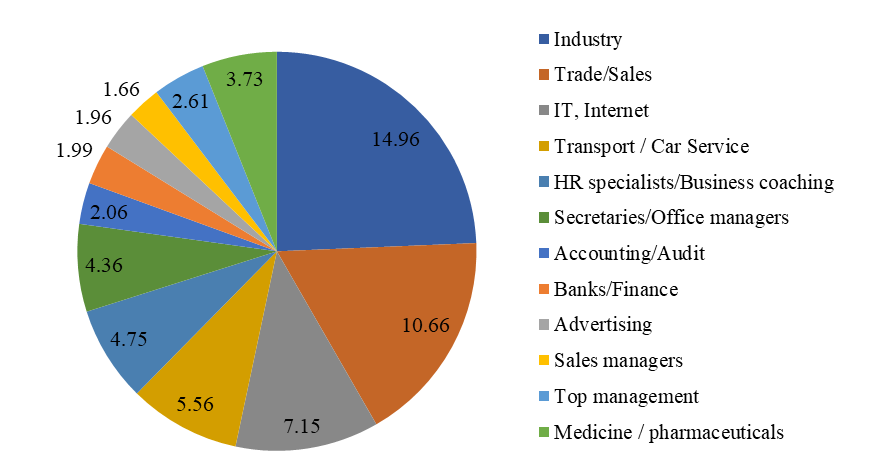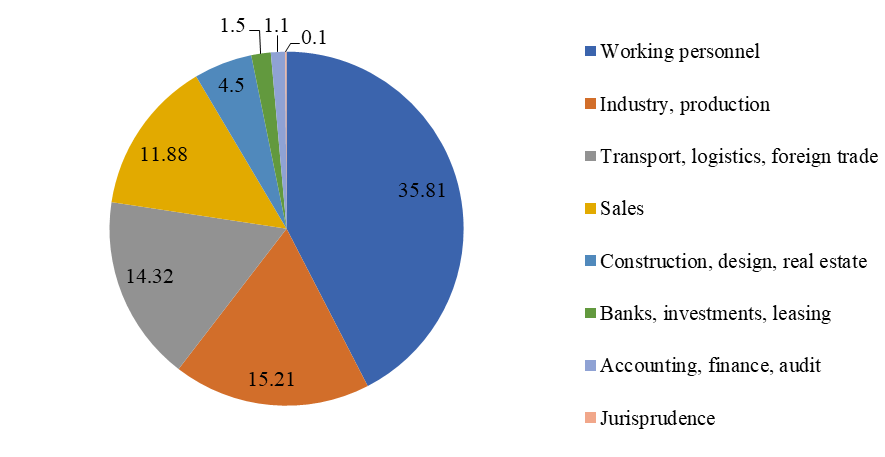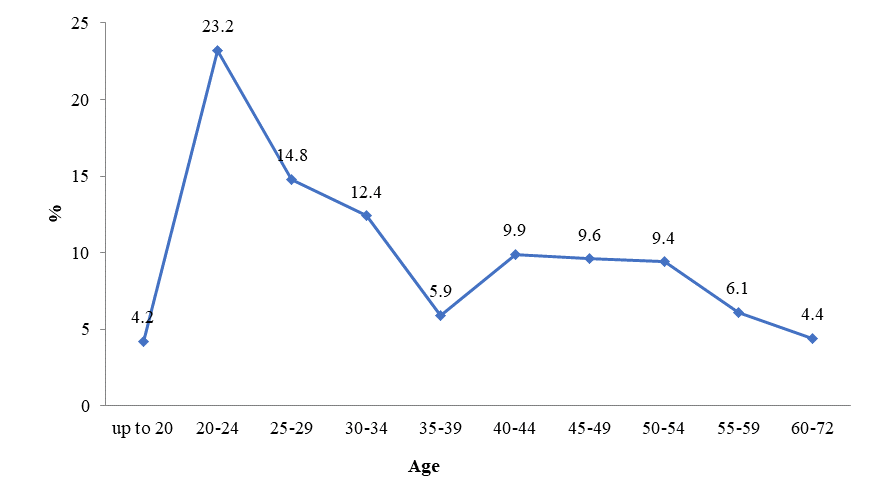Abstract
The research novelty is caused by disequilibrium between demand and supply on the labor market in quantitative and structural relations. It is manifested through unemployment and shortage of human resources. As a result, it negatively affects the state economy productivity and growth. Among the most significant problems that cause an imbalance in demand and supply indicators in the labor market, the impact of education on the employment structure of young professionals is particularly noticeable. Monitoring the employment level allows ensuring the timely management of measures aimed at improving the socio-economic indicators. The regional labor market is analyzed, and the need for specialists of certain industry categories and educational levels is estimated. The authors analyzed regional higher and secondary educational institutions taking into account the number of graduates and applicants in various academic fields. The results are compared with the unemployment rate in the studied region. Factors reducing the imbalance in the labor market are determined. It is proposed to develop measures aimed at targeted interaction between employers and educational institutions; to form the structure of education, taking into account the current and future demand on the labor market, to create conditions for professional socialization of future specialists; to form a conscious choice of school graduates of their future profession, based on an analysis of the real needs of the labor market. The research results can be useful for studying the employment and unemployment level in the region and developing regional policy directions to eliminate structural imbalances in the labor market.
Keywords: Labor marketeducationemploymentunemploymentyoung professionals
Introduction
A special place in market relations is occupied by processes regulating demand and supply in the labor market. This is characterized by indicators of the total supply of the economically active population, and the total demand, reflecting the economy's need for labor. The relevance of research of these issues is explained by the lack of needed balance between demand and supply indicators in the labor market in quantitative and structural terms. In the first case, the lack of balance between supply and demand in the labor market is manifested through unemployment and labor shortages, which, in turn, negatively affects the labor productivity and the growth rate of the country’s economy. The imbalance of quality indicators is determined by a variety of characteristics, each of which, as a rule, exacerbates the negative impact of the first indicators. Structural indicators are characterized by the ratio of age, gender, and educational characteristics of the labor force to the necessary combination of them for the most productive growth of the country's economy.
Problem Statement
Among factors that cause an imbalance in demand and supply indicators in the labor market, the influence of education on the employment structure of young professionals is particularly noticeable. The problem of inconsistency of educational institutions with labor market is determined by processes of deformation and deprofessionalization of labor force, the increase in the number of graduates and dissatisfaction of the economy’s needs ( Kostina & Orlova, 2016). In this aspect, a number of factors are involved, ranging from the choice of an educational institution by applicants to the search for employment by graduates. In most cases, when choosing a specialty, applicants are guided not by the analysis of real needs in the labor market, but by the public opinion about the prestige of the chosen profession and educational institution, which, in turn, creates an overabundance of specialists in some areas and a deficit in other ones (so called ‘unclaimed areas’). Exceeding the required number of specialists in a particular field generates a decrease in wages, causes disappointment in the choice that was made by applicants ( Melnikova, 2017). The discrepancy between the education received by the employee and skills required for work also causes dissatisfaction with the profession. There are significant differences between graduates from countries that focus on general education and countries that focus on work. Easier employment of graduates in the work systems is determined by the initial orientation to the employment ( Choi, Jeong, & Kim, 2019).
Research Questions
Monitoring the employment level among the population allows ensuring timely management of measures aimed at improving the state socio-economic indicators, such as increasing the standard of life of the population, improving the production efficiency, developing science and increasing the labor productivity. In most cases, it is typical for young professionals to use knowledge and skills acquired in the educational institutions at the beginning of their working life ( Forster & Bol, 2018). Analysis of the situation on the labor market in the Samara region allows us to assess the need for specialists of certain industrial categories and educational levels. In addition, it is necessary to study the sphere of higher and secondary educational institutions in the region in terms of the number of graduates and applicants in various fields of training. Correlation of the obtained results with the unemployment rate in the considered region enables to determine the impact factors reducing the imbalance in the labor market.
Purpose of the Study
Developing a strategy for reducing labor market imbalances involves building various models to assess the usefulness of education for the practical application of the acquired skills ( Memon & Liu, 2019). The main purpose of comparing the studied factors is to identify patterns that affect the structure of demand for specialists, analyze the employment and unemployment state of the Samara region, and develop recommendations for reducing the imbalance of supply and demand in the labor market.
Research Methods
The results of one Swiss survey show that employment prospects are approximately the same for workers with secondary and higher professional education in the second half of their working life. However, secondary vocational education in Switzerland determines a significantly lower level of wages, guaranteeing protection from unemployment ( Korber & Oesch, 2019).
The structure of demand for labor force by the industrial characteristic in the Samara region can be analyzed by the number of vacancies provided by employers. The largest number of vacancies posted in the manufacturing industry in 2019 is 15% of the total number. The trade sector needs about 11% of the total number of posted vacancies (Figure

At the same time, the presence of secondary special education is required for the employment in 47% of vacancies, 34% of vacancies do not require education at all, and only for 19% of employers, the presence of higher education is a prerequisite for the employment.
A similar situation in the Samara region for the same period is observed according to the website SuperJob.ru. Almost 36% of all posted vacancies are employees: 15% are specialists in the industry and production; transport, logistics, foreign trade – 14%, sales – 12%. Vacancies in the financial sector are less than 2%, and in the legal sector – less than 1% (Figure

It is important to note that 59.3% of applicants can apply for posted vacancies without having a higher education. In 2018, 18 state and 11 non-state higher education institutions (HEIs) and their branches were located on the territory of the Samara region. The number of secondary education institutions (SEIs) was 104 units, i.e. in quantitative terms, the number of HEIs exceeds the number of SEIs by more than 3.5 times. At the same time, in 2018, the number of students enrolled in secondary vocational education institutions was almost 32% less than those enrolled in the higher education. The number of applicants who chose higher education institutions for training exceeds the number of applicants of secondary education institutions by 22.8%. The number of university graduates was 31.75% higher than the number of SEIs graduates (Table
The employment structure by age groups in 2017 indicates that employment among young people under the age of 20 was only 0.3%. There is a decrease in this indicator compared to 2007 by 1.1% (1.4%). Among the population aged 20 to 24, the employment rate for the same period was only 4.3%, which reflects the dynamics of a decrease in this indicator by 4.6% (8.9%) compared to 2007.
Indicators of the unemployment rate for 2017 indicate that the age limits of the unemployed population fall on the group from 20 to 24 years, which is 23.2% of the total number of unemployed youth during the studied period (Figure

Thus, the results of this study indicate a direct impact of educational characteristics on the employment structure of young professionals and, as a result, determine the specifics of the supply and demand interaction in the labor market as a whole.
Findings
Employment and professional education spheres are closely related to each other and have a significant impact on the level of structural imbalances in the labor market. The study showed that in the Samara region, there is a shortage of specialists in the production and industry sector, and a lack of working personnel was identified too. In most cases, employers' requirements for the educational level of potential employees are minimal. The key point in this case is the set of necessary skills to perform the work and the learning ability of employees. At the same time, there is a shift in the educational structure in the Samara region towards higher education.
The desire of young people to obtain higher education is a positive factor that theoretically should lead to the economic growth. However, the rash choice of the profession of the younger generation causes difficulties with their future employment. According to Russian scientists, by 2025, 80% of young people will have higher education, while in the labor market, 80% of vacancies will be working specialties ( Bogatyreva & Kuznetsova, 2018). The results of the study indicate a high level of unemployment among the population in the Samara region and the need to develop a regional policy to eliminate the structural imbalance in the labor market.
Conclusion
Managing the mechanism for the development of the regional production potential should be considered through the creation of a vertically integrated system with state and professional organizations that allows organizing cooperation at various managerial and economic levels ( Simonova, Gunko, Kolesnikov, & Parshin, 2019). A structural imbalance in the labor market occurs when the level of demand for labor and its supply do not match. The relation between the employment sector and the vocational education system at the regional level is initiated by the development of a set of measures aimed at strengthening the cooperation between educational institutions at all levels with employers. The formation of an education structure based on the cooperation with the real economy sector, which determines the demand model in the labor market, allows creating conditions for the professional socialization of future specialists and conscious choice of their future profession by school graduates, based on an analysis of real needs of the labor market. Thus, employers and employees can themselves act as both customers and consumers of educational services, taking into account the emerging trends in the economic development of the state.
References
- Bogatyreva, M. R., & Kuznetsova, N. K. (2018). Unbalanced supply and demand in the regional labor market. Bulletin of the Altai Academy of Economics and Law, 5, 56-61. [in Rus.].
- Choi, S. J., & Jeong, J. C., & Kim, S. N. (2019). Impact of vocational education and training on adult skills and employment: An applied multilevel analysis. International Journal of Educational Development, 66, 129-138. DOI: 10.1016/j.ijedudev.2018.09.007
- Federal State Statistics Service (2018). Samara Statistical Yearbook. Retrieved from https://samarastat.gks.ru/folder/34255 Accessed: 21.11.2019. [in Rus.].
- Forster, A. G., & Bol, T. (2018). Vocational education and employment over the life course using a new measure of occupational specificity. Social Science Research, 70, 176-197. DOI: 10.1016/j.ssresearch.2017.11.004
- Korber, M., & Oesch, D. (2019). Vocational versus general education: Employment and earnings over the life course in Switzerland. Advances in Life Course Research, 40, 1-13. DOI: 10.1016/j.alcr.2019.03.003
- Kostina, E. Y., & Orlova, N. A. (2016). Choice of employment career by Russian students in modern labor market conditions. Indian Journal of Science and Technology, 9(44). DOI: 10.17485/ijst/2016/v9i44/104710
- Melnikova, A. S. (2017). The impact of the educational services market on labor supply and demand. In O.N. Shirokov (Ed.), Science, Education, Society: Trends and Prospects of Development. Collection of materials of the VII International scientific and practical conference (pp. 279-281). Cheboksary: CNS “Interactive Plus”. [in Rus.].
- Memon, A. A., & Liu, Z. (2019). Assessment of sustainable development of the performance of higher education credentials in the transitive labor market. Sustainability, 11(9), 1-14.
- Simonova, M. V., Gunko, N. N., Kolesnikov, S. A., & Parshin, A. N. (2019). Structure of the performance management at the regional level. In V. Mantulenko (Ed.), Proceedings of “Eurasia: Sustainable Development, Security, Cooperation – 2019”, SHS Web of Conferences, 71 (04007). Les Ulis: EDP Sciences. DOI: 10.1051/shsconf/20197104007
- SuperJob (2019). Jobs, recent vacancies, job search and resumes. Retrieved from: https://www.superjob.ru/ vacancy/search/?keywords=. Accessed: 21.11.2019. [in Rus.].
- TRUD (2019). Work in Samara. Retrieved from: https://samara.trud.com/. Accessed: 21.11.2019. [in Rus.].
- Unified Information System of the Ministry of education and science of the Russian Federation (2019). Analytical forms FSN VPO-1, SPO-1. Retrieved from http://eis.mon.gov.ru/education/sitepages/ %D0%92%D0%9F%D0%9E_%D0%A4%D0%BE%D1%80%D0%BC%D1%8B.aspx?Paged=TRUE&p_SortBehavior=0&p_FileLeafRef=%D0%A0%D1%8F%D0%B7%D0%B0%D0%BD%D1%81%D0%BA%D0%B0%D1%8F%20%D0%BE%D0%B1%D0%BB%D0%B0%D1%81%D1%82%D1%8C_%D0%93%D0%9E%D0%A1_%D0%BE%D1%87%D0%BD%D0%B0%D1%8F%2exls&p_ID=302&PageFirstRow=541&&View=%7BE0B706DF-7882-4F3E-A7C6-552131378073%7D. Accessed: 21.11.2019. [in Rus.].
Copyright information

This work is licensed under a Creative Commons Attribution-NonCommercial-NoDerivatives 4.0 International License.
About this article
Publication Date
01 April 2020
Article Doi
eBook ISBN
978-1-80296-081-5
Publisher
European Publisher
Volume
82
Print ISBN (optional)
-
Edition Number
1st Edition
Pages
1-1004
Subjects
Business, innovation, management, management techniques, development studies
Cite this article as:
Gunko, N. N., & Dinukova, O. A. (2020). Impact Of Education On The Structure Of Youth Employment. In V. V. Mantulenko (Ed.), Problems of Enterprise Development: Theory and Practice, vol 82. European Proceedings of Social and Behavioural Sciences (pp. 874-880). European Publisher. https://doi.org/10.15405/epsbs.2020.04.111
